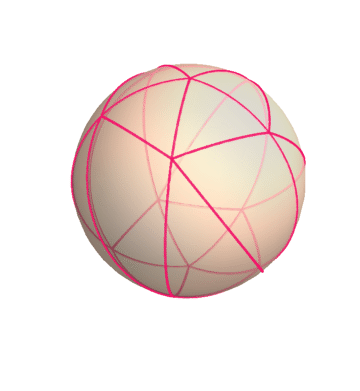
Spherical Polygons and Areas¶
Overview¶
In this notebook, we will calculate how to use spherical polygons on a unit sphere to determine areas and perimeters.
Calculate area and permieter of quadrilateral patch on a unit sphere
Determine if a given point is within a spherical polygon
Mean center of spherical polygon
Prerequisites¶
| Concepts | Importance | Notes |
|---|---|---|
| Numpy | Necessary | Used to work with large arrays |
| Pandas | Necessary | Used to read in and organize data (in particular dataframes) |
| Intro to Cartopy | Helpful | Will be used for adding maps to plotting |
| Matplotlib | Helpful | Will be used for plotting |
Time to learn: 20 minutes
Imports¶
Import Packages
Setup location dataframe with coordinates
import pandas as pd # reading in data for location information from text file
import numpy as np # working with arrays, vectors, cross/dot products, and radians
from pyproj import Geod # working with the Earth as an ellipsod (WGS-84)
from shapely.geometry import Point
from shapely.geometry.polygon import Polygon
import matplotlib.pyplot as plt # plotting a graph
from cartopy import crs as ccrs, feature as cfeature # plotting a world map# Get all Coordinates for Locations
location_df = pd.read_csv("../location_full_coords.txt")
location_df = location_df.rename(columns=lambda x: x.strip()) # strip excess white space from column names and values
location_df.head()location_df.index = location_df["name"]Area and Perimeter of quadrilateral patch¶
We can make use of the pyproj Python package to calculate the area and perimeter of a patch formed by a list of latitude and longitude coordinates for an ellipsoid or a unit sphere.
def area_of_polygon_ellps(poly_pts=None):
geod = Geod(ellps="WGS84")
longitudes = [location_df.loc[pt, "longitude"] for pt in poly_pts]
latitudes = [location_df.loc[pt, "latitude"] for pt in poly_pts]
poly_area_m, poly_perimeter_m = geod.polygon_area_perimeter(longitudes, latitudes)
return abs(poly_area_m) * 1e-6, poly_perimeter_m/1000 # km^2 and km
def area_of_polygon_unit_sphere(poly_pts=None):
geod = Geod(ellps="sphere") # 'sphere': {'a': 6370997.0, 'b': 6370997.0, 'description': 'Normal Sphere (r=6370997)'
longitudes = [location_df.loc[pt, "longitude"] for pt in poly_pts]
latitudes = [location_df.loc[pt, "latitude"] for pt in poly_pts]
poly_area_m, poly_perimeter_m = geod.polygon_area_perimeter(longitudes, latitudes)
return abs(poly_area_m) * 1e-6, poly_perimeter_m/1000 # km^2 and kmLet’s compare how area and perimeter vary based on whether you use an ellpsoid like WGS-84 and a unit sphere. The changes will become more pronounced as you move further towards the poles.
area_ellps, perimeter_ellps = area_of_polygon_ellps(["boulder", "boston",
"arecibo", "houston"])
area_us, perimeter_us = area_of_polygon_unit_sphere(["boulder", "boston",
"arecibo", "houston"])
print(f"Area Ellipsoid = {area_ellps} km^2")
print(f"Area Unit Sphere = {area_us} km^2")
print(f"Perimeter Ellipsoid = {perimeter_ellps} km")
print(f"Perimeter Unit SPhere = {perimeter_us} km")
print(f"Roughly {(area_ellps/509600000)*100:.2f}% of the Earth's Surface")
print(f"Roughly {(area_us/509600000)*100:.2f}% of the Earth's Surface")Area Ellipsoid = 5342585.6476998255 km^2
Area Unit Sphere = 5344606.94796931 km^2
Perimeter Ellipsoid = 10171.738963248145 km
Perimeter Unit SPhere = 10170.504728302833 km
Roughly 1.05% of the Earth's Surface
Roughly 1.05% of the Earth's Surface
Plot Area of Quadrilateral Patch¶
Let’s see what spherical polygons looks like on a world map!
def plot_area(pt_lst=None,
lon_west=-180, lon_east=180,
lat_south=-90, lat_north=90):
# Set up world map plot
fig = plt.subplots(figsize=(15, 10))
projection_map = ccrs.PlateCarree()
ax = plt.axes(projection=projection_map)
ax.set_extent([lon_west, lon_east, lat_south, lat_north], crs=projection_map)
ax.coastlines(color="black")
ax.add_feature(cfeature.STATES, edgecolor="black")
# plot points
longitudes = [location_df.loc[x, "longitude"] for x in pt_lst] # longitude
latitudes = [location_df.loc[y, "latitude"] for y in pt_lst] # latitude
plt.scatter(longitudes, latitudes, s=100, c="red")
plt.fill(longitudes, latitudes, alpha=0.5)
# determine the area and perimeter
area_ellps, perimeter_ellps = area_of_polygon_ellps(pt_lst)
area_us, perimeter_us = area_of_polygon_unit_sphere(pt_lst)
print(f"Ellipsoid Area = {area_ellps} km^2")
print(f"Unit Sphere Area = {area_us} km^2")
plt.title(f"Roughly {(area_ellps/509600000)*100:.2f}% ({(area_us/509600000)*100:.2f}%) of the Earth's Surface")
plt.show()plot_area(["boulder", "boston", "greenwich", "cairo", "arecibo", "houston"])Ellipsoid Area = 21872449.378265787 km^2
Unit Sphere Area = 21896220.663299154 km^2
/home/runner/micromamba/envs/cookbook-gc/lib/python3.13/site-packages/cartopy/io/__init__.py:242: DownloadWarning: Downloading: https://naturalearth.s3.amazonaws.com/110m_physical/ne_110m_coastline.zip
warnings.warn(f'Downloading: {url}', DownloadWarning)
/home/runner/micromamba/envs/cookbook-gc/lib/python3.13/site-packages/cartopy/io/__init__.py:242: DownloadWarning: Downloading: https://naturalearth.s3.amazonaws.com/110m_cultural/ne_110m_admin_1_states_provinces_lakes.zip
warnings.warn(f'Downloading: {url}', DownloadWarning)
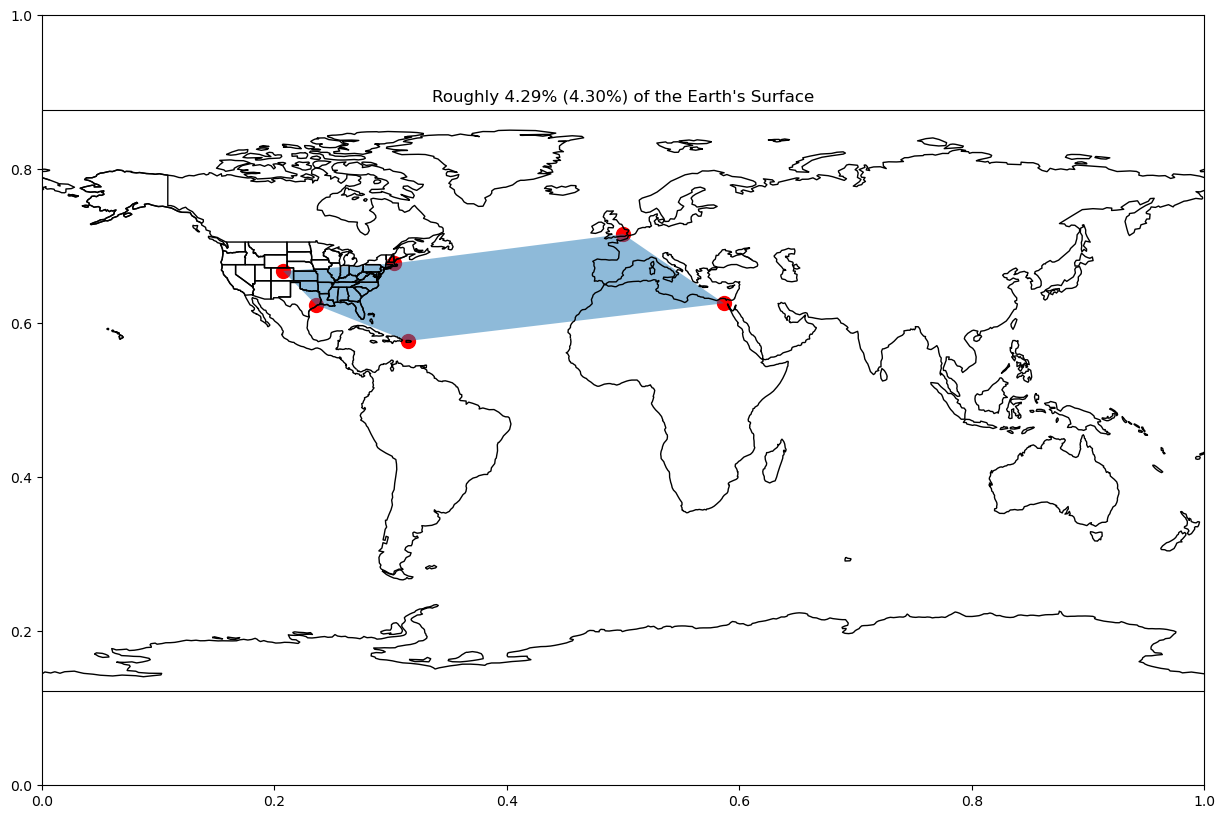
plot_area(["redwoods", "rockford", "boston", "houston",], -130, -60, 20, 60)Ellipsoid Area = 3150946.426714995 km^2
Unit Sphere Area = 3149017.3086414044 km^2
/home/runner/micromamba/envs/cookbook-gc/lib/python3.13/site-packages/cartopy/io/__init__.py:242: DownloadWarning: Downloading: https://naturalearth.s3.amazonaws.com/50m_cultural/ne_50m_admin_1_states_provinces_lakes.zip
warnings.warn(f'Downloading: {url}', DownloadWarning)
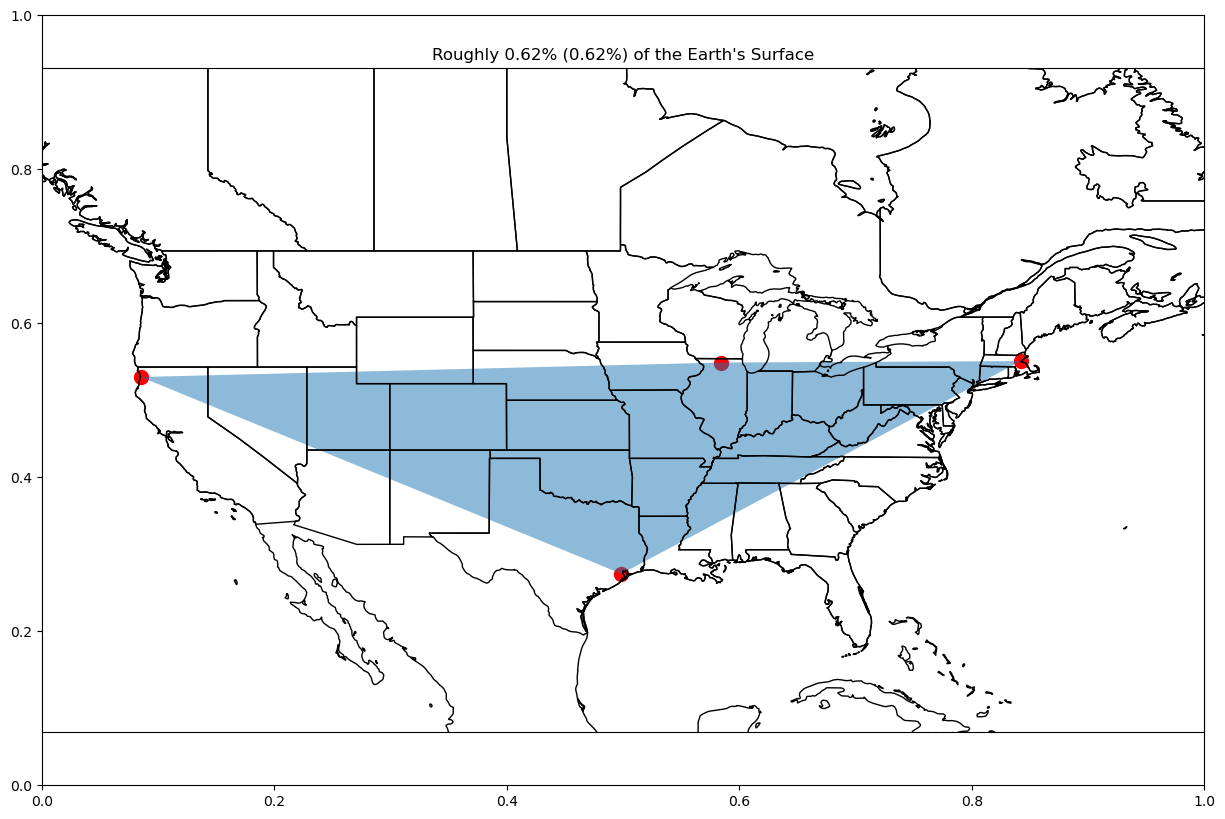
plot_area(["redwoods", "boston", "houston"], -130, -60, 20, 60)Ellipsoid Area = 3788155.432965353 km^2
Unit Sphere Area = 3782548.632737316 km^2
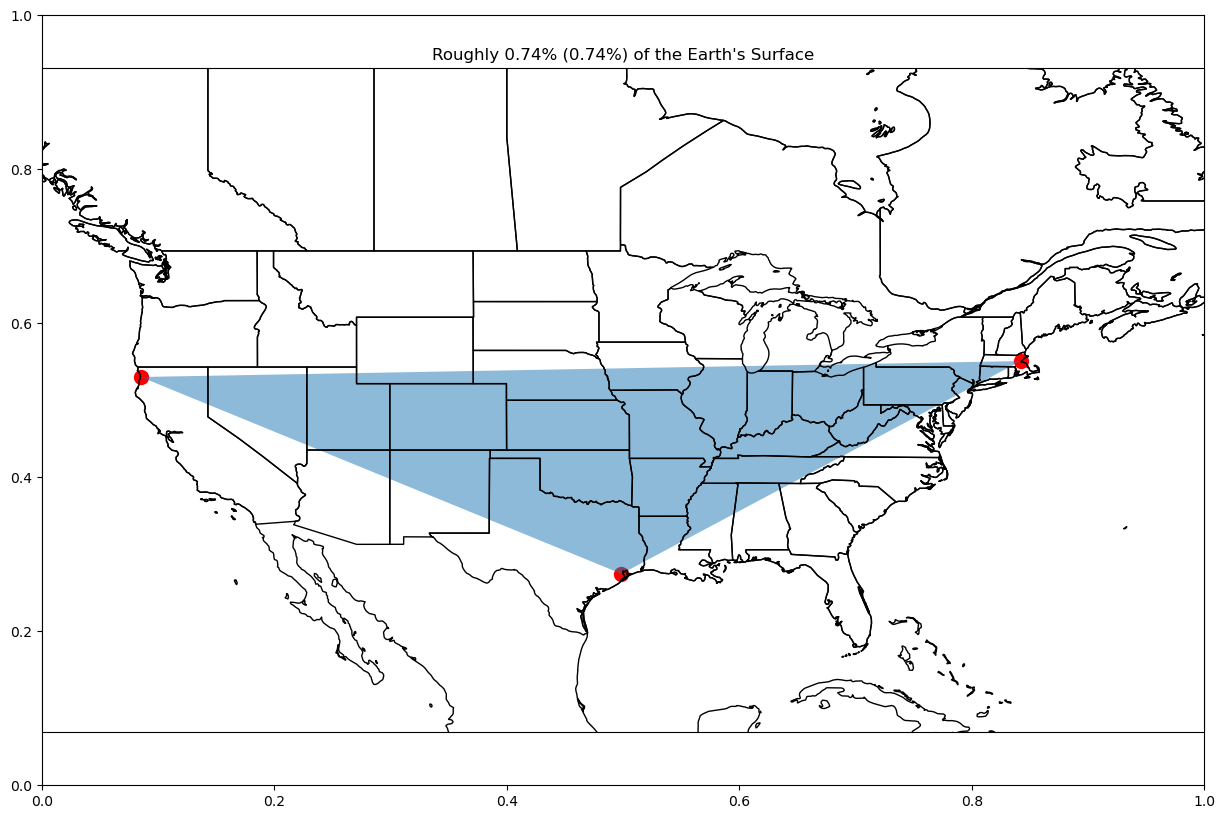
# For example: here is a list of unordered points
plot_area(["boulder", "boston", "houston", "boston", "cairo", "arecibo", "greenwich"])Ellipsoid Area = 914381.1786067598 km^2
Unit Sphere Area = 954445.989927043 km^2

Determine if a given point is within a spherical polygon¶
Now that we have a spherical polygon, how can be determine if a new point lies within the area of the polygon? The shapely Python package makes this quite easy, let’s give it a shot!
def polygon_contains_points(pt_lst=None, polygon_pts=None):
longitudes = [location_df.loc[pt, "longitude"] for pt in polygon_pts]
latitudes = [location_df.loc[pt, "latitude"] for pt in polygon_pts]
lat_lon_coords = tuple(zip(longitudes, latitudes))
# setup polygon
polygon = Polygon(lat_lon_coords)
# check if new point lies within the polygon
contains = np.vectorize(lambda pt: polygon.contains(Point((location_df.loc[pt, "longitude"],
location_df.loc[pt, "latitude"]))))
contained_by_polygon = contains(np.array(pt_lst))
return contained_by_polygonpolygon_contains_points(["boulder"], ["redwoods", "boston", "houston"])array([ True])Plot and See if New Point within Polygon¶
On a map, it can be fairly intuitive to see if a point lies within a polygon or not. Let’s give it a shot!
def plot_polygon_pts(pt_lst=None, polygon_pts=None,
lon_west=-180, lon_east=180,
lat_south=-90, lat_north=90):
# Set up world map plot
fig = plt.subplots(figsize=(15, 10))
projection_map = ccrs.PlateCarree()
ax = plt.axes(projection=projection_map)
ax.set_extent([lon_west, lon_east, lat_south, lat_north], crs=projection_map)
ax.coastlines(color="black")
ax.add_feature(cfeature.STATES, edgecolor="black")
# plot polygon points
longitudes = [location_df.loc[x, "longitude"] for x in polygon_pts] # longitude
latitudes = [location_df.loc[y, "latitude"] for y in polygon_pts] # latitude
plt.scatter(longitudes, latitudes, s=50, c="blue")
plt.fill(longitudes, latitudes, alpha=0.5)
# plot check points
pt_lst = np.array(pt_lst)
contains_pts = polygon_contains_points(pt_lst, polygon_pts)
longitudes = [location_df.loc[x, "longitude"] for x in pt_lst[contains_pts]] # longitude
latitudes = [location_df.loc[y, "latitude"] for y in pt_lst[contains_pts]] # latitude
plt.scatter(longitudes, latitudes, s=100, c="green", label="Within Polygon")
longitudes = [location_df.loc[x, "longitude"] for x in pt_lst[~contains_pts]] # longitude
latitudes = [location_df.loc[y, "latitude"] for y in pt_lst[~contains_pts]] # latitude
plt.scatter(longitudes, latitudes, s=100, c="red", label="Not within Polygon")
plt.legend(loc="lower left")
plt.title(f"Points contained within polygon = {pt_lst[contains_pts]}, not contained = {pt_lst[~contains_pts]}")
plt.show()polygon_contains_points(["boulder"], ["redwoods", "boston", "houston"])array([ True])plot_polygon_pts(["boulder"], ["redwoods", "boston", "houston"],
-130, -60, 20, 60)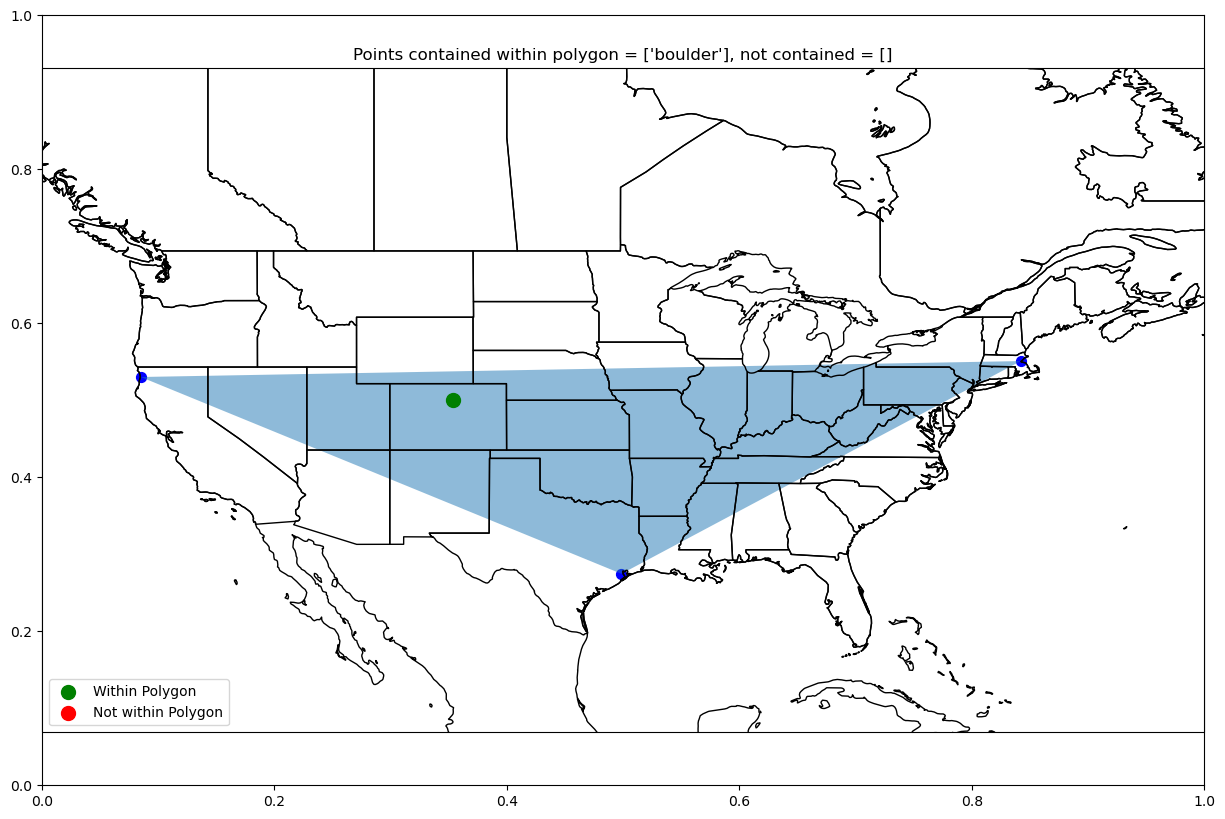
polygon_contains_points(["cape canaveral"], ["redwoods", "boston", "houston"])array([False])plot_polygon_pts(["cape canaveral"], ["redwoods", "boston", "houston"],
-130, -60, 20, 60)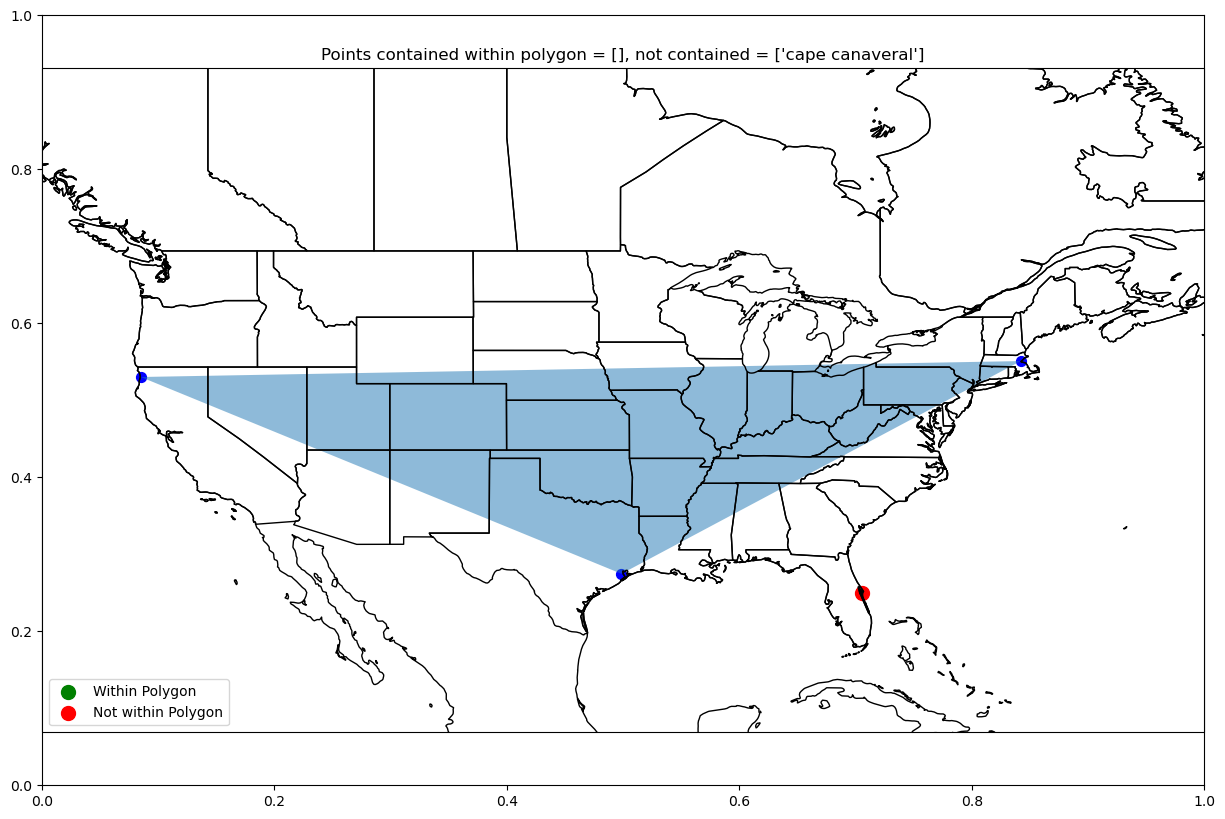
plot_polygon_pts(["boulder", "cape canaveral"], ["redwoods", "boston", "houston"],
-130, -60, 20, 60)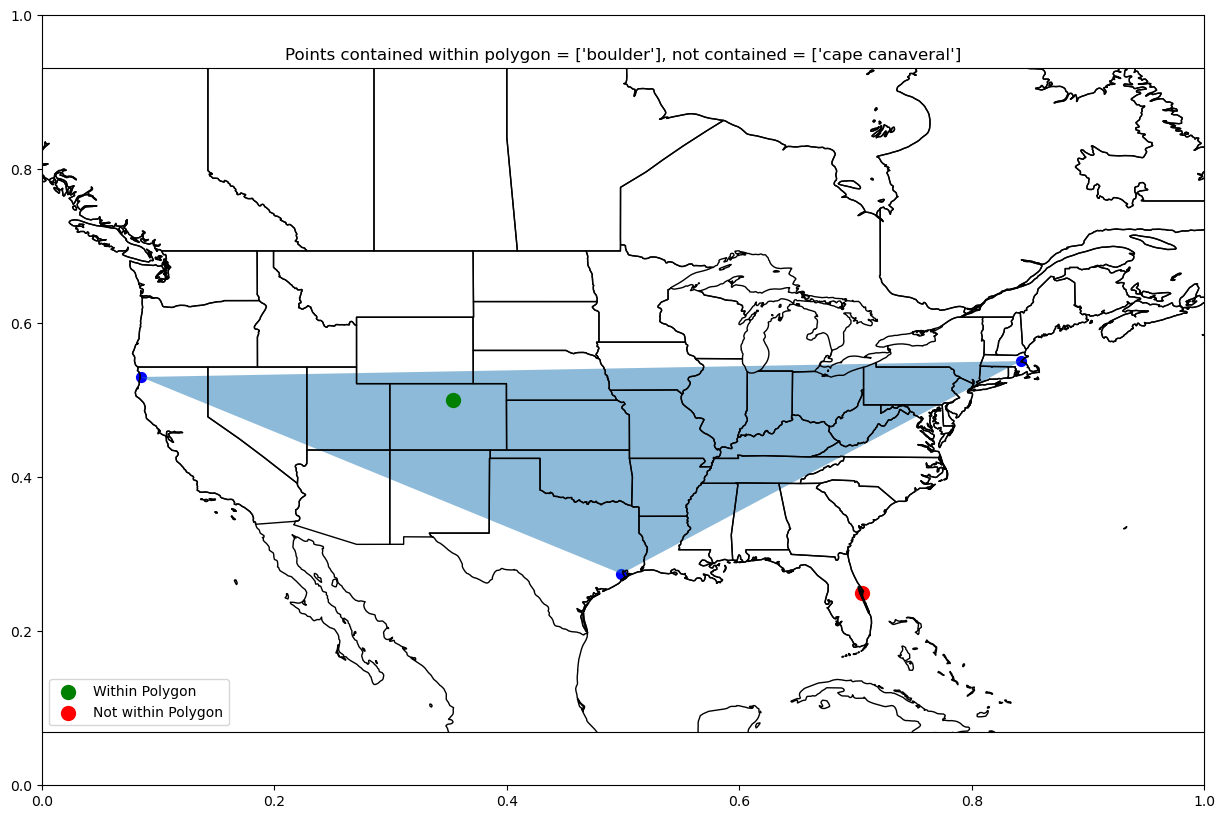
plot_polygon_pts(["boulder", "redwoods"], ["rockford", "boston", "cape canaveral"],
-130, -60, 20, 60)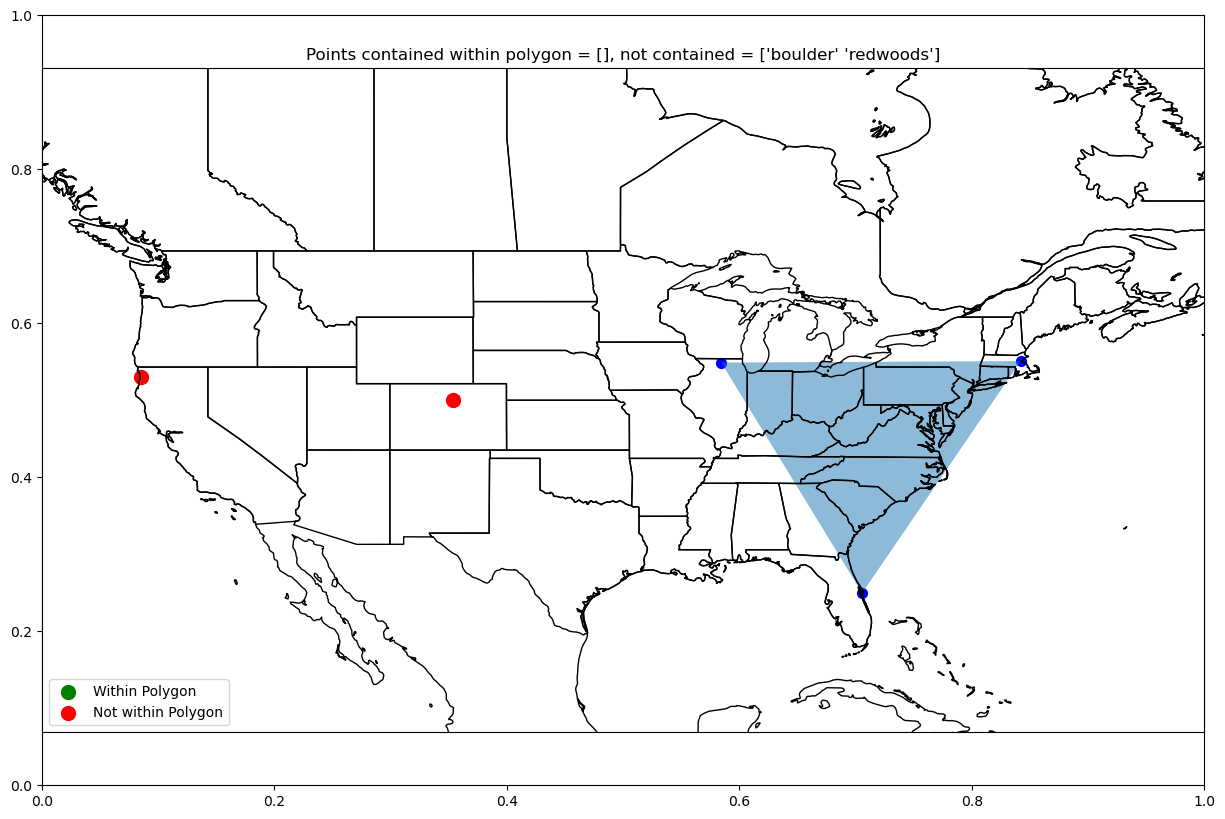
Mean center of spherical polygon¶
A spherical polygon can have a fairly regular shape, especially as more points are added. But it is fairly simple using the shapley Python package to determine the mean center.
def polygon_centroid(polygon_pts=None):
longitudes = [location_df.loc[x, "longitude"] for x in polygon_pts]
latitudes = [location_df.loc[y, "latitude"] for y in polygon_pts]
lat_lon_coords = tuple(zip(longitudes, latitudes))
polygon = Polygon(lat_lon_coords)
return (polygon.centroid.y, polygon.centroid.x)polygon_centroid(["boulder", "boston", "houston"])(37.30896666666666, -90.47586666666665)Plot Centroid¶
The center of a polygon can be fairly apparently on a map, let’s give it a look!
def plot_centroid(polygon_pts=None,
lon_west=-180, lon_east=180,
lat_south=-90, lat_north=90):
# Set up world map plot
fig = plt.subplots(figsize=(15, 10))
projection_map = ccrs.PlateCarree()
ax = plt.axes(projection=projection_map)
ax.set_extent([lon_west, lon_east, lat_south, lat_north], crs=projection_map)
ax.coastlines(color="black")
ax.add_feature(cfeature.STATES, edgecolor="black")
# plot polygon points
longitudes = [location_df.loc[x, "longitude"] for x in polygon_pts] # longitude
latitudes = [location_df.loc[y, "latitude"] for y in polygon_pts] # latitude
plt.scatter(longitudes, latitudes, s=50, c="blue")
plt.fill(longitudes, latitudes, alpha=0.5)
# plot check point
centeroid = polygon_centroid(polygon_pts)
plt.scatter(centeroid[1], centeroid[0], s=100, c="red")
plt.title(f"Centroid = {centeroid}")
plt.show()plot_centroid(["boulder", "boston", "houston"],
-130, -60, 20, 60)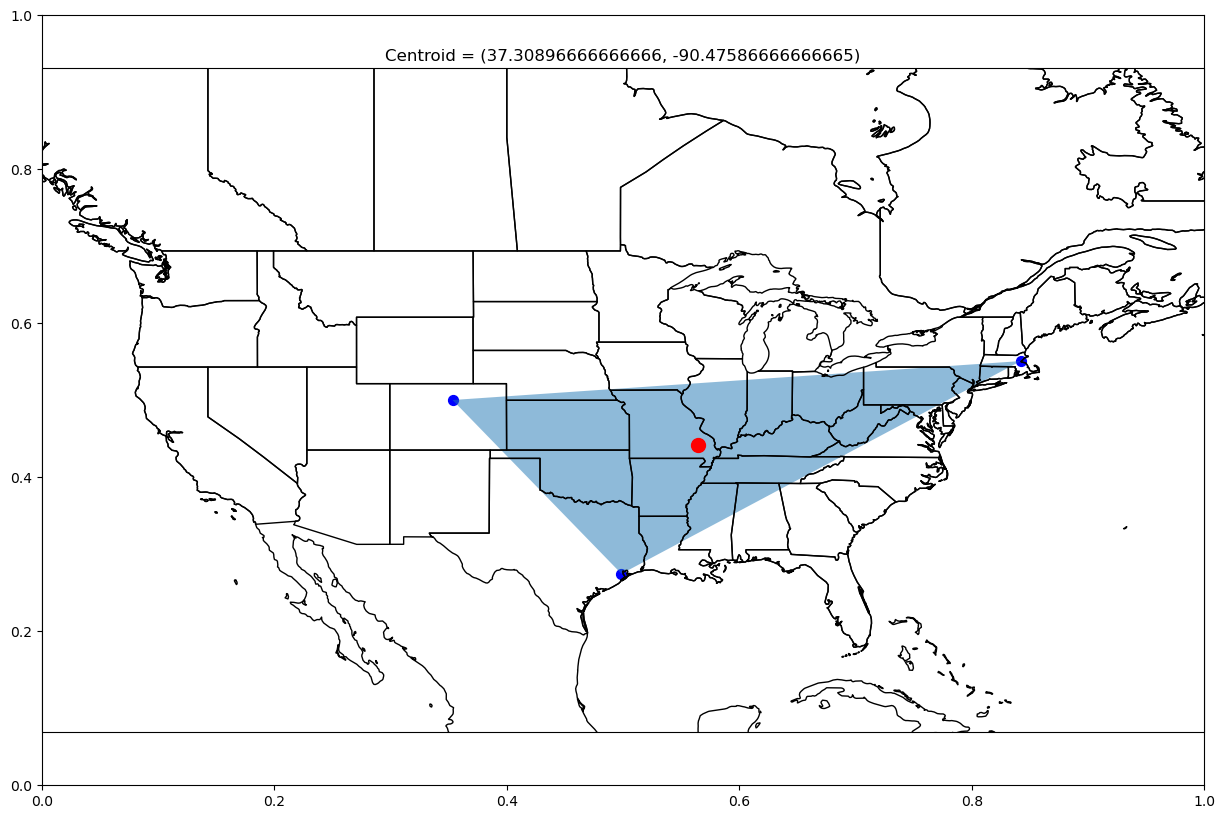
plot_centroid(["redwoods", "boulder", "cape canaveral", "houston"],
-130, -60, 20, 60)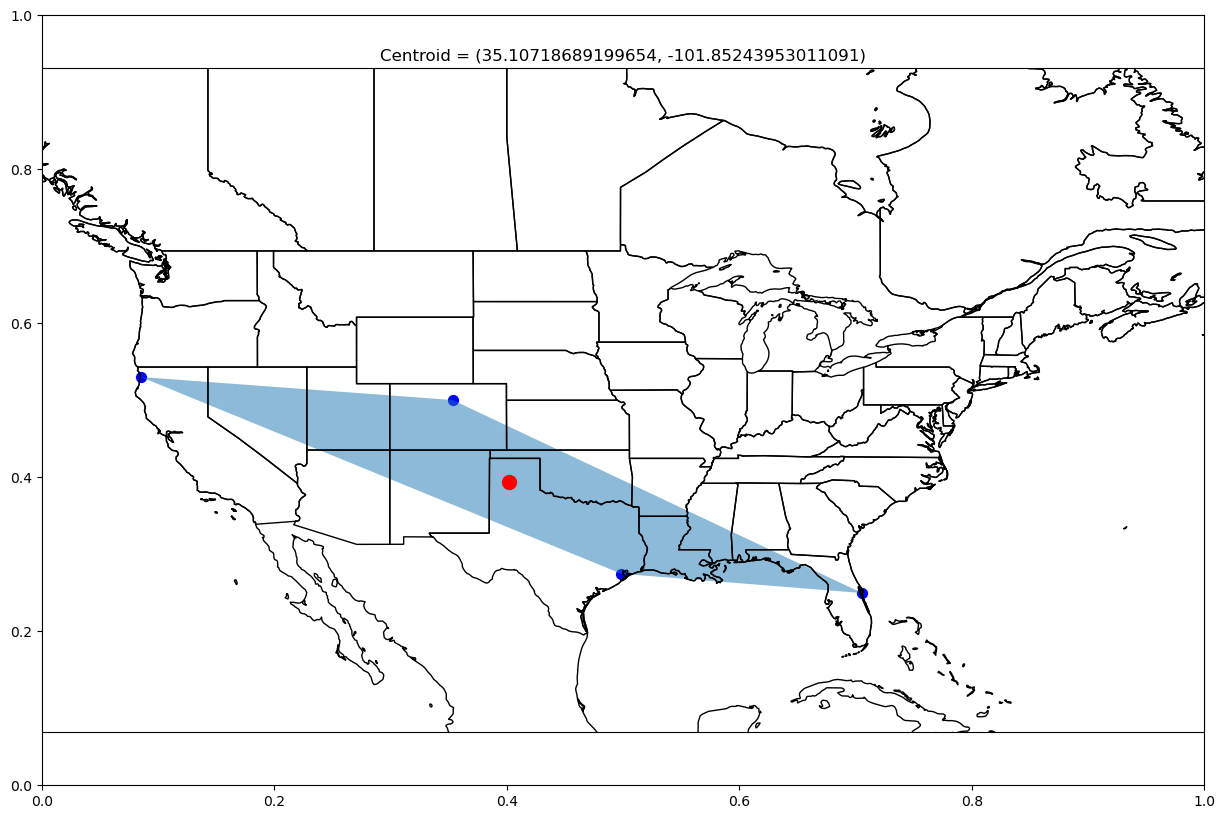
Summary¶
This notebook covers working with spherical polygons to determine the ordering of coordinates, center of polygons, and whether or not a point lies within a spherical polygon